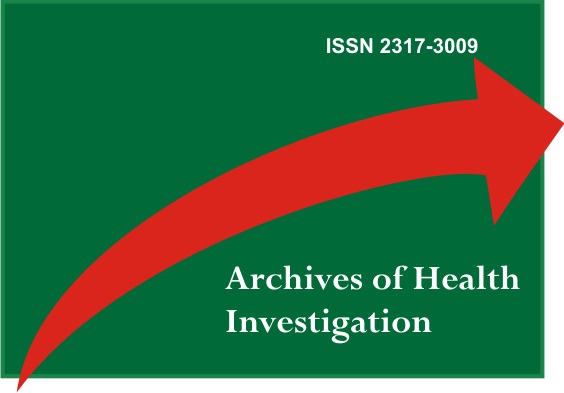Evaluation of the quality of life and the impact of pain in patients with temporomandibular disorder
DOI:
https://doi.org/10.21270/archi.v10i2.5201Palavras-chave:
Síndrome da Disfunção da Articulação Temporomandibular, Qualidade de Vida, Dor Facial, Perfil de Impacto da DoençaResumo
Objective: To evaluate the quality of life and the impact of pain in patients with Temporomandibular Disorder (TMD) Muscle/joint TMJ of a public institution in Brazil. Methods: The study consisted of two stages: the first step was the application of the Ohip-14 questionnaires, Fonseca's Anamnestic Questionnaire and the McGill Questinionaire (Br-MPQ). In the next step, after the clinical treatment, only the Ohip-14 questionnaire was applied to compare the results after the treatment. The significance level was set at α = 0,05. Results: Overall, 100 individuals were examined and diagnosis with TMD Muscle/joint TMJ. The score OHIP-14 scale before the treatment was 30.02 ± 1.26 (mean ± standard error of the mean) points, being that after treatment it was 8.94 ± 0.63 points, statistically significant (p<0,001). The mean score in the Fonseca scale was 73.25 ± 1.93 points. Regarding the Br-MPQ, the results showed that TMD pain affects the patient in the area of work, leisure, home activities, family relationships, relationships with friends, sleep and appetite. Conclusion: SERDOF-DTM patients had severe TMD with a negative impact on quality of life, directly affecting their daily activities. The treatment proved to be effective in improving this condition.
Downloads
Referências
Locker D, Grushka M. The impact of dental and facial pain. J Dent Res. 1987;66(9):1414-17.
Biazevic MGH, Araújo ME, Michel-Crosato E. Indicadores de qualidade de vida relacionados com a saúde bucal: revisão sistemática. Rev Odontol. 2002;4(1):13-25.
Parker MW. A dynamic model of etiology in temporomandibular disorders. J Am Dent Assoc. 1990;120(3):283-90.
Bocchi EA, Kuhn AMB, Nascimento RSGF. Características psicológicas de pacientes com queixa de disfunção da articulação temporomandibular. Psikhe. 2000;5(1):70-6.
Donnarumma MD, Muzilli CA, Ferreira C, Nemr K. Disfunções temporomandibulares: sinais, sintomas e abordagem multidisciplinar. Rev CEFAC. 2010;12(5):788-94.
Fonseca DMD, Bonfante G, Valle ALD, Freitas SFTD. Diagnóstico pela anamnese da disfunção craniomandibular. RGO. 1994;42(1):23-4.
Barros Vde M, Seraidarian PI, Côrtes MI, de Paula LV. The impact of orofacial pain on the quality of life of patients with temporomandibular disorder. J Orofac Pain. 2009;23(1):28-37.
John MT, Reissmann DR, Schierz O, Wassell RW. Oral health-related quality of life in patients with temporomandibular disorders. J Orofac Pain. 2007;21(1):46-54.
Biasotto-Gonzalez DA, Mendes PC, Jesus LA, Martins MD. Qualidade de vida em portadores de disfunção temporomandibular: um estudo transversal. Rev Inst Ciênc Saúde. 2009;27(2):128-32.
Pimenta CAM, Teixeira MJ - McGill Pain Questionnaire: adaptation into the portuguese language Rev Bras Anestesiol. 1997;47(2):177-86.
Rowe P. Essential statistics for the pharmaceutical sciences. Chichester, England: John Wiley & Sons; 2007.
Lacerda JT, Traebert J, Zambenedetti ML. Dor orofacial e absenteísmo em trabalhadores da indústria metalúrgica e mecânica. Saude soc. 2008;17(4):182-91.
Kuroiwa DN, Marinelli JG, Rampani MS, Oliveira W, Nicodemo D. Desordens temporomandibulares e dor orofacial: estudo da qualidade de vida medida pelo Medical Outcomes Study 36 - Item Short Form Health Survey. Rev dor. 2011;12(2):93-8.
Oliveira AS, Bermudez CC, Souza RA, Souza CMF, Dias EM, Castro CES et al . Impacto da dor na vida de portadores de disfunção temporomandibular. J Appl Oral Sci. 2003;11(2):138-43.
Lemos GA, Paulino MR, Forte FDS, Beltrão RTS, Batista AUD. Influência da presença e gravidade da disfunção temporomandibular na qualidade de vida relacionada com a saúde oral. Rev dor. 2015;16(1):10-4.


